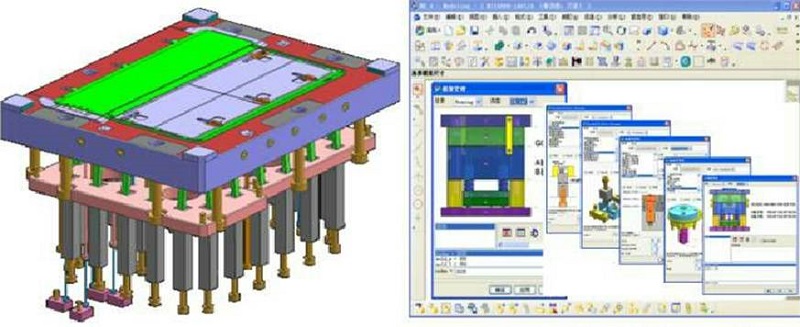
 English
English  Español
Español Português
Português русский
русский Français
Français 日本語
日本語 Deutsch
Deutsch tiếng Việt
tiếng Việt Italiano
Italiano Nederlands
Nederlands ภาษาไทย
ภาษาไทย Polski
Polski 한국어
한국어 Svenska
Svenska magyar
magyar Malay
Malay বাংলা ভাষার
বাংলা ভাষার Dansk
Dansk Suomi
Suomi हिन्दी
हिन्दी Pilipino
Pilipino Türkçe
Türkçe Gaeilge
Gaeilge العربية
العربية Indonesia
Indonesia Norsk
Norsk تمل
تمل český
český ελληνικά
ελληνικά український
український Javanese
Javanese فارسی
فارسی தமிழ்
தமிழ் తెలుగు
తెలుగు नेपाली
नेपाली Burmese
Burmese български
български ລາວ
ລາວ Latine
Latine Қазақша
Қазақша Euskal
Euskal Azərbaycan
Azərbaycan Slovenský jazyk
Slovenský jazyk Македонски
Македонски Lietuvos
Lietuvos Eesti Keel
Eesti Keel Română
Română Slovenski
Slovenski मराठी
मराठी Srpski језик
Srpski језик
How to reduce mold costs, where is the root cause?
2023-07-06
When it comes to mold cost control, many small and medium-sized mold enterprises first think of the following methods:
Is the mold material changed from imported steel to cheap domestic steel?
Make the materials as thin as possible to save materials?
Reduce processing volume?
Less thimbles and inserts?
Less design and processing of waterways?
Try not to use Hot runner?
String cooling water pipes together to reduce water pipe joints
Basically, it's all about saving costs from materials and processing costs, but the concept is actually wrong, do you know? You only see the surface of the cost. The above methods are precisely increasing costs, not reducing costs, because the mold design needs to provide sufficient safety factors for material strength, and the cost of modifying and testing the mold is definitely much greater than the material cost due to material issues?
 So, optimizing the mold structure in the design process while ensuring the required performance of the mold itself is the biggest cost optimization:
So, optimizing the mold structure in the design process while ensuring the required performance of the mold itself is the biggest cost optimization:
Firstly, the mold ejection design should be sufficient, rather than excessive, rather than problems such as product protrusion, ejection imbalance, or product ejection deformation caused by saving ejector pins. The loss caused by one modification of the mold trial is much greater than a few ejector pins;
Second: Don't make less inserts because of reducing processing costs. In difficult to process areas, the local flow end of the product should be made into inserts as far as possible, and enough exhaust slots should be made on the inserts. Making more inserts seems to increase costs, but in fact, it will reduce a lot of molding risks. The processing amount of the inserts is small, and the inserts can be processed synchronously to shorten the Makespan of the mold; The insert is beneficial for exhaust, shortens filling time, reduces forming pressure, and reduces various product defects caused by trapped air;
Thirdly, there should be as many cooling water channels for the mold as possible, and balance and rationality should also be considered, especially for large and thick products. Multiple design and processing waterways seem to increase costs. If the product forming cycle can be reduced by 3-5 seconds, would it better reflect the value of the mold;
Fourthly, in order to reduce the number of joints in the design of cooling water circuits, it is also an extremely wrong idea to connect many water circuits in series. Some on-site injection molding personnel directly connect multiple waterways for convenience. If the cooling water flows too long in the mold, the water temperature will increase, and there will be significant differences in the inlet and outlet temperatures, which can affect the cooling effect of the product and even cause deformation of the product due to uneven cooling;
Fifth: Mold design should proactively communicate with customers, identify areas where customer products are prone to modification and areas where mold production is prone to damage, and prepare plans in advance to facilitate subsequent mold modifications. If it can be quickly replaced with inserts or spare parts in advance, it is necessary to make a plan in advance, otherwise it will result in high repair costs;
Sixth: Mold design should be designed with as much exhaust as possible, and exhaust should be reasonably designed and processed; Many small and medium-sized mold enterprises do not design exhaust grooves in their mold design, and on-site fitters handle them based on experience, which is very wrong; Designing and processing exhaust seems to be a waste of cost, and exhaust problems are a very important factor causing product problems, which should be taken seriously. The benefits of exhaust are not explained in detail here;
Seventh: The parts of mold design must have tolerance standards, and processing and testing must be carried out according to tolerance requirements. Some factories do not have detailed tolerance standards at all, and if the processing is not qualified, the supervisor often signs for special procurement. These are all hidden dangers that cause mold problems and increase the cost of modifying the mold.
In short, mold design must fully consider the cost of subsequent mold modifications and injection molding production. The mold is for injection molding services, and comprehensive costs should be considered. Some companies only produce molds and sell them to customers for injection molding, neglecting injection molding production in order to control mold costs. In the long run, these mold factories will be abandoned by customers, even if their mold prices are low and lack quality is scrap iron. Only by fully considering injection molding production is a good mold.
Is the mold material changed from imported steel to cheap domestic steel?
Make the materials as thin as possible to save materials?
Reduce processing volume?
Less thimbles and inserts?
Less design and processing of waterways?
Try not to use Hot runner?
String cooling water pipes together to reduce water pipe joints
Basically, it's all about saving costs from materials and processing costs, but the concept is actually wrong, do you know? You only see the surface of the cost. The above methods are precisely increasing costs, not reducing costs, because the mold design needs to provide sufficient safety factors for material strength, and the cost of modifying and testing the mold is definitely much greater than the material cost due to material issues?

Firstly, the mold ejection design should be sufficient, rather than excessive, rather than problems such as product protrusion, ejection imbalance, or product ejection deformation caused by saving ejector pins. The loss caused by one modification of the mold trial is much greater than a few ejector pins;
Second: Don't make less inserts because of reducing processing costs. In difficult to process areas, the local flow end of the product should be made into inserts as far as possible, and enough exhaust slots should be made on the inserts. Making more inserts seems to increase costs, but in fact, it will reduce a lot of molding risks. The processing amount of the inserts is small, and the inserts can be processed synchronously to shorten the Makespan of the mold; The insert is beneficial for exhaust, shortens filling time, reduces forming pressure, and reduces various product defects caused by trapped air;
Thirdly, there should be as many cooling water channels for the mold as possible, and balance and rationality should also be considered, especially for large and thick products. Multiple design and processing waterways seem to increase costs. If the product forming cycle can be reduced by 3-5 seconds, would it better reflect the value of the mold;
Fourthly, in order to reduce the number of joints in the design of cooling water circuits, it is also an extremely wrong idea to connect many water circuits in series. Some on-site injection molding personnel directly connect multiple waterways for convenience. If the cooling water flows too long in the mold, the water temperature will increase, and there will be significant differences in the inlet and outlet temperatures, which can affect the cooling effect of the product and even cause deformation of the product due to uneven cooling;
Fifth: Mold design should proactively communicate with customers, identify areas where customer products are prone to modification and areas where mold production is prone to damage, and prepare plans in advance to facilitate subsequent mold modifications. If it can be quickly replaced with inserts or spare parts in advance, it is necessary to make a plan in advance, otherwise it will result in high repair costs;
Sixth: Mold design should be designed with as much exhaust as possible, and exhaust should be reasonably designed and processed; Many small and medium-sized mold enterprises do not design exhaust grooves in their mold design, and on-site fitters handle them based on experience, which is very wrong; Designing and processing exhaust seems to be a waste of cost, and exhaust problems are a very important factor causing product problems, which should be taken seriously. The benefits of exhaust are not explained in detail here;
Seventh: The parts of mold design must have tolerance standards, and processing and testing must be carried out according to tolerance requirements. Some factories do not have detailed tolerance standards at all, and if the processing is not qualified, the supervisor often signs for special procurement. These are all hidden dangers that cause mold problems and increase the cost of modifying the mold.
In short, mold design must fully consider the cost of subsequent mold modifications and injection molding production. The mold is for injection molding services, and comprehensive costs should be considered. Some companies only produce molds and sell them to customers for injection molding, neglecting injection molding production in order to control mold costs. In the long run, these mold factories will be abandoned by customers, even if their mold prices are low and lack quality is scrap iron. Only by fully considering injection molding production is a good mold.
We use cookies to offer you a better browsing experience, analyze site traffic and personalize content. By using this site, you agree to our use of cookies.
Privacy Policy


